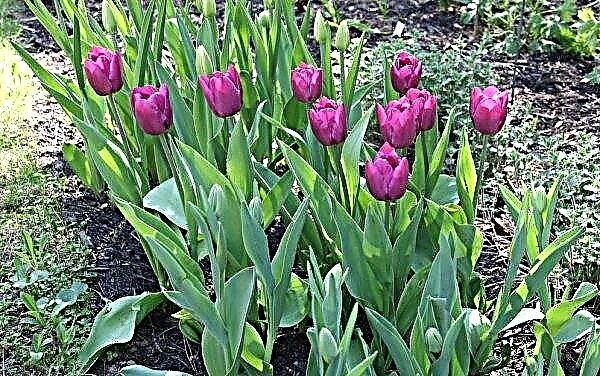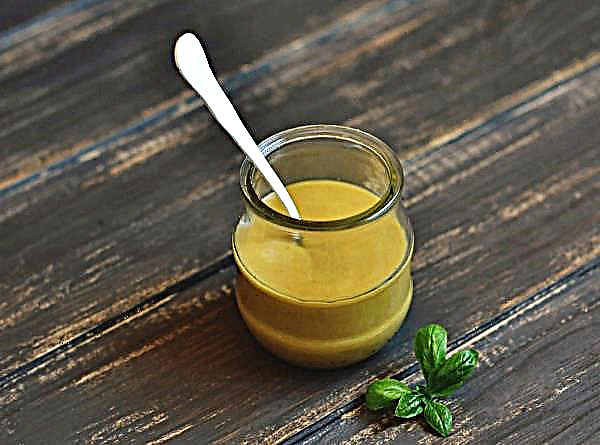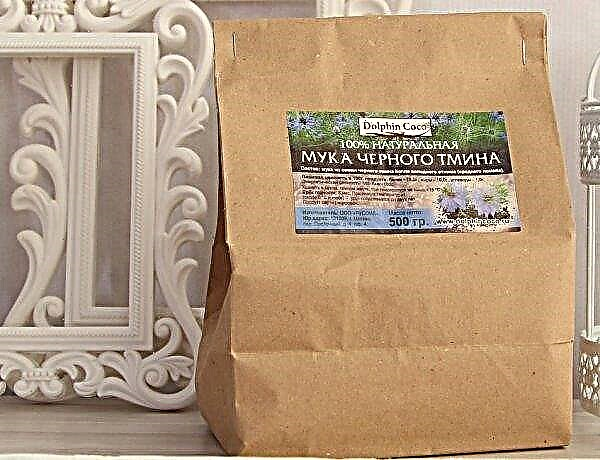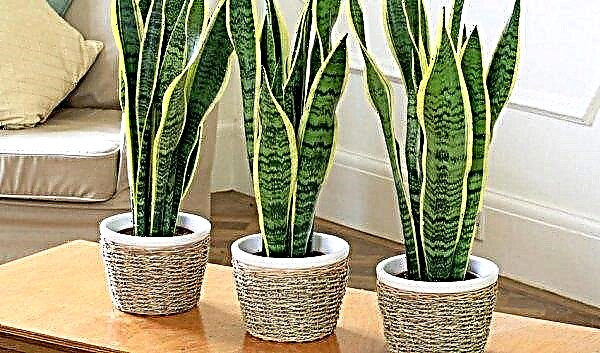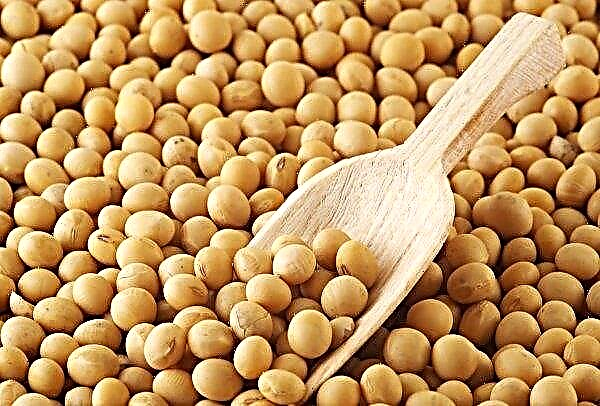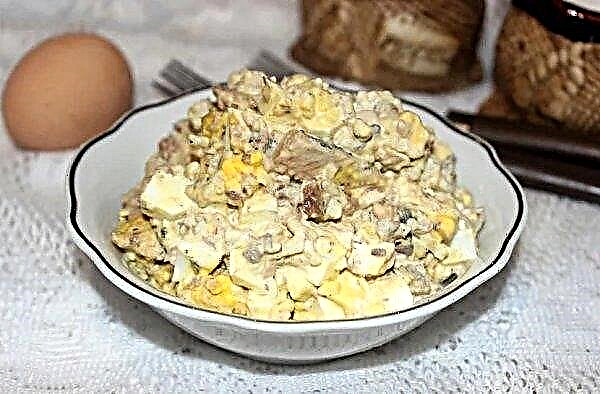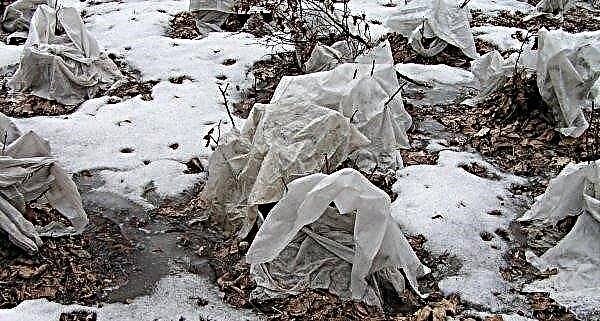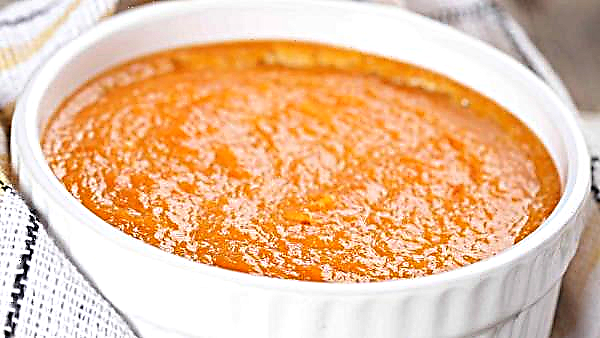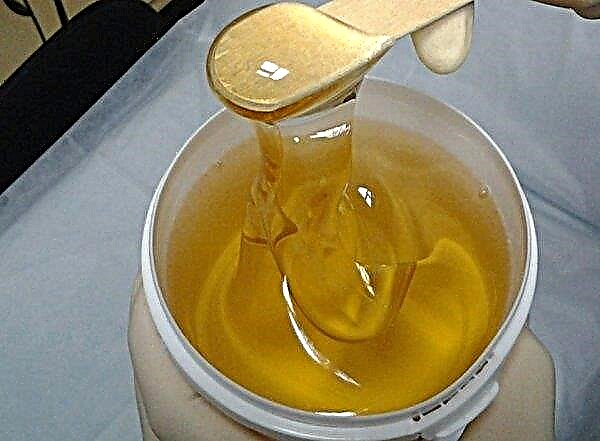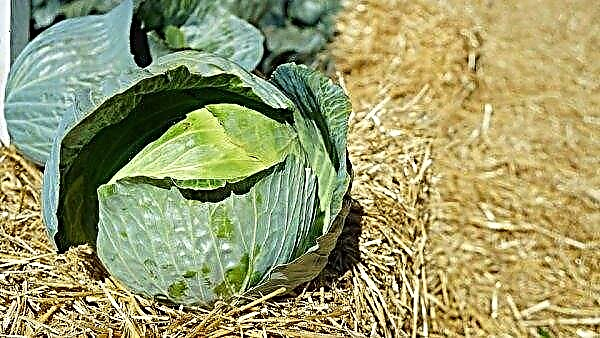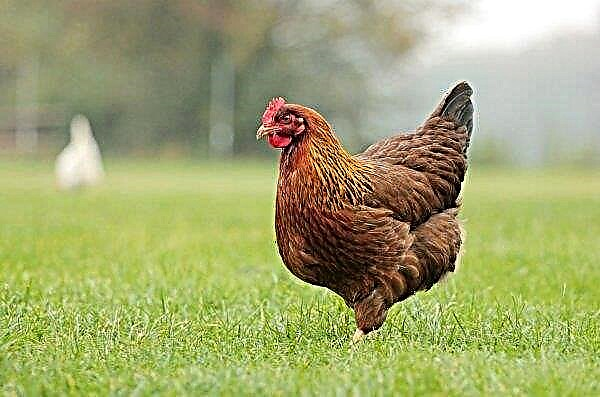Ornamental hydrangea shrubs with large green leaves and chic caps of inflorescences can be found in gardens and parks almost throughout Russia, with the exception of the Far North. They are quite demanding of care and react to improper growing conditions with a significant loss of decorativeness. That is why gardeners should know why hydrangeas form small flowers.
Causes of the appearance of small inflorescences and solutions to the problem
It often happens that the owner of a garden grows one of the varieties of hydrangea for several years, but is not satisfied with how it blooms. Small, sparse, or deformed inflorescences can form for many reasons.
Did you know? The owner of hydrangea with pink inflorescences can easily change its color to blue or dark blue. To do this, it is enough to increase the acidity in the soil by regularly watering the shrub with water mixed with vinegar, citric acid or potassium alum (sodium, ammonium).
This can be either improper pruning, scarce or excessive watering, and frozen fruit buds, lack of nutrients, the development of diseases or the attack of pests. In order to timely correct deficiencies in care, the gardener needs to know what the diseased shrub signals.
Incorrect pruning
The crop should be trimmed with the plant variety. This is mainly due to the formation of fruit buds on annual or biennial shoots. Mowing the bush at the wrong time also means that little inflorescences are subsequently formed and they will be small. Most often this applies to large-leaved hydrangea (macrophyllum). If pruning is never performed at all, the plant will produce less and less flowers from year to year.
To stimulate the formation of beautiful hydrangea flowers, it is worth acting as follows:
- In the case of the formation of an oak-leaved, petiolate, or large-leaved hydrangea, minimal trimming is performed. In early spring, only overwintered dry inflorescences are removed just above the first pair of buds.
- For flowering hydrangea on the shoots of this year, that is, bouquet and shrub species, the stems are removed every spring at a height of 20 cm, about 3 or 4 buds. Also cut out all the thin branches. After this pruning, new strong processes with large inflorescences will form.
 Freezing is the most common reason that hydrangea flowers become smaller. That is why, during its landing, it is required to choose a place that is not only located in partial shade, but also protected from cold northerly winds. If the growing region has stably harsh winters, then the tops of the stems (or the bush completely) are insulated for the entire period. To do this, you can form a high mound of garden peat or chopped bark, or use coniferous branches. Also for protection against freezing, you can use caps made of non-woven material of high density.
Freezing is the most common reason that hydrangea flowers become smaller. That is why, during its landing, it is required to choose a place that is not only located in partial shade, but also protected from cold northerly winds. If the growing region has stably harsh winters, then the tops of the stems (or the bush completely) are insulated for the entire period. To do this, you can form a high mound of garden peat or chopped bark, or use coniferous branches. Also for protection against freezing, you can use caps made of non-woven material of high density.
In panicled and tree-like hydrangeas, the tips of the shoots freeze every winter - this is normal and not problematic, because the shrubs have enough fruit buds and the bottom of the branches. Much more damage can be caused by night spring frosts, after which freshly-bloomed leaves die. Buds are also damaged, especially if they are no longer completely covered by bracts. Depending on the intensity of subzero temperatures, the nascent inflorescences are destroyed partially or completely.
Did you know? Biologists know that in nature there is such a ratio: the fewer flowers or fruits formed on a plant, the larger they will be.
To prevent damage from frost, in spring, it is worthwhile to carefully monitor the weather forecast, and if necessary, cover young bushes with agrofiber for the night. If frost damage has already occurred, it is best to trim all affected branches to a healthy pair of buds. Sometimes only the earliest blossoming leaves and buds freeze at the ends of the shoots, and the buds below are still alive and can bloom in summer.
Underdeveloped root system
Small inflorescences occur in recently transplanted plants that have not yet had time to adapt to a new place. Usually in this case, the root system is shallow and weakened, which causes the shrub to feel a lack of nutrients and moisture. To correct the situation, It is recommended that the gardener perform foliar top dressing, during which a liquid solution containing fertilizers is applied to branches and leaves.
This procedure allows hydrangia to quickly receive nutrition, absorbing it through cell membranes. For these purposes, it is recommended to purchase ready-made fertilizers for hydrangeas or azaleas in garden shops. They are sprayed over the aerial part of the bush using a pump-action sprayer.
Unsuitable landing site
Hydrangeas do not like location in direct sunlight. But they should not be too shaded, because it badly affects the abundance and quality of colors. As for most plants pollinated by insects, it is important for the culture to be where the probability of the presence of bees and flies is maximum. Usually this is a warm and well-lit place, so for shrubs the best location is a flower bed, which is in the shade only during the hot midday hours.
Usually this is a warm and well-lit place, so for shrubs the best location is a flower bed, which is in the shade only during the hot midday hours.
Important! If hydrangeas grow near the northern wall of the building or in the shadow of a high fence, then their inflorescences will be small, and the stems of the bush— thin.
Wrong watering
Hydrangia is very demanding on soil moisture. It is advisable that throughout the summer months the substrate in the basal zone is constantly slightly moist. Drying of the root coma should not be allowed, since the plant responds to this by instantly wilting leaves and the formation of sparse small inflorescences. The frequency of watering the crop depends on the weather: in a hot bush, a weekly supply of 8-10 liters of water is sufficient.
Diseases and pests
When hydrangea is grown in an inappropriate place or several bushes are planted too close to each other, these circumstances often cause an outbreak of fungal diseases. The culture is affected by gray mold, powdery mildew, or leaf spotting.. As a result of infection with fungal spores, the plant weakens, lags in growth and, as a result, forms small, nondescript inflorescences or even completely loses them.
That is why it is so important to ensure the correct conditions for hydrangea vegetation, to diagnose fungal diseases in a timely and correct manner and to process the aerial parts with medicinal substances. For therapeutic and preventive purposes, plants should be sprayed several times a season with one of the preparations containing fungicide: Trichoderm, Previkur, Fundazol, Falcon, Split. Also, small hydrangea inflorescences can signal that the aphid has attacked the bush.
Important! Hydrangea hydrangea is carried out only under the root. Rainwater becomes the cause of the rapid development of fungal diseases, after which the flowers of the plant become smaller, and the leaves become covered with mold and spots.
At the same time, clusters of tiny dark green or black insects appear on the tops of the shoots and on the underside of the leaves. Parasites feed on cells and plant juices, weakening hydrangea. They are the reason why culture does not bloom or produce few buds, often distorted and ugly. As soon as the first signs of the presence of aphids are observed, it is necessary to spray the aerial part of the bush with an insecticide such as Karate Zeon 050 CS or Aktara.
Video: hydrangea diseases and pests
Artificial flowering stimulation
To get large flower hats, the gardener needs to reduce their number on the plant. This is conveniently done using a garden pruner. For work, choose the period when they are just being formed and have a diameter of 5–7 cm. On an adult shrub older than 5 years, it is recommended to leave no more than 30–35 inflorescences. To the fact that hydrangea will form tiny flowers or there will be few of them, a lack of nutrients can lead. In this case, the complete absence of the formation of fruiting kidneys is not excluded.
Important! If hydrangeas grow very rapidly, but at the same time look thin and brittle, the gardener should analyze the soil. Excessive nitrogen intake combined with phosphate deficiency is often the cause of depletion.
Wrong Hydrangea Variety
The nondescript hydrangea flowers will upset the wearer if initially the wrong crop variety was made during planting. For example, in the cold northern climate, macrophylla, a thermophilic garden hydrangea, was cultivated. Accordingly, the plant will hurt, need reliable shelter for the winter, and fruit buds will periodically freeze on it. Hydrangea macrophylla. But if in the same climate plant frost-resistant varieties of hydrangia (tree-like or panicled) are planted, with minimal shelter, the bushes will form huge caps of flowers annually. The gardener should consider that potted hydrangea, grown indoors, will bloom smaller flowers than its variety cultivated in open ground.
Hydrangea macrophylla. But if in the same climate plant frost-resistant varieties of hydrangia (tree-like or panicled) are planted, with minimal shelter, the bushes will form huge caps of flowers annually. The gardener should consider that potted hydrangea, grown indoors, will bloom smaller flowers than its variety cultivated in open ground.
Plant youth
It will take some time until a young hydrangea grown from seeds or by rooting the cuttings forms full-fledged large flowers. Usually this happens only in the fourth or fifth year of the growing season. While the plant is growing up and gradually adapting, only small inflorescences are formed on it every summer.
Did you know? In countries with a cold climate, thermophilic hydrangea can be grown year-round — like a pot culture. With good care and additional illumination, the plant will bloom well in room conditions.
The gardener can accelerate the onset of full flowering by adding nutrients necessary for the culture to the soil - phosphorus, nitrogen, potassium. Much faster after transplantation, a young bush adapted after separation of the rhizome of the mother plant adapts. Already in the second year of vegetation, large lush flowers can form on it.
What to do for hydrangea to have large flowers
For the full growth and development of large inflorescences, the culture needs proper nutrition. To fertilize hydrangea, you can use granules or liquid solutions supplied directly to the roots ("Biopon", "Planton", "Agrecol", "Master"). A properly balanced fertilizer covers the needs of plants in macro- and microelements, and a high potassium content improves the general condition, stimulates flowering and facilitates the formation of fruit buds for the next season. Nutrients nitrogen and phosphorus have very different effects on shrub growth. While nitrogen mainly promotes vegetative growth, that is, the formation of shoots and leaves, phosphorus is necessary for the formation of large flowers.
A properly balanced fertilizer covers the needs of plants in macro- and microelements, and a high potassium content improves the general condition, stimulates flowering and facilitates the formation of fruit buds for the next season. Nutrients nitrogen and phosphorus have very different effects on shrub growth. While nitrogen mainly promotes vegetative growth, that is, the formation of shoots and leaves, phosphorus is necessary for the formation of large flowers.
In most garden soils, phosphorus is present in sufficient quantities, because it is very firmly bound to soil particles and due to this it is almost not washed out by water. It is advisable to give nitrogen fertilizers at the beginning of the warm season to build up the above-ground mass, and completely stop their supply already in the second half of summer. This is due to the fact that due to rapid growth, winter hardiness of the crop may suffer.
Video: how to achieve a chic flowering hydrangea
How to strengthen hydrangea stems
Insufficiently thick shoots of hortensia cannot hold heavy hats of flowers and bend down to the ground under their weight. The stems lose their vertical orientation, decay, white or pink petals get dirty in the dust, thereby significantly reducing the decorativeness of the plant.
There are several reasons for the formation of too thin hydrangea branches:
- Overgrown old bush. In this case, the side shoots deprive the light of the branches growing in the center. After all the numerous leaves are opened, hydrangea gets too little space for development, it has limited access to the sun and air. In this case, it is recommended in the spring to divide the rhizome into several young plants and plant them. If this operation is already too late this year, you can periodically cut off most of the aboveground processes directly from the ground during the summer, leaving only 10-15 of the most developed shoots to bloom.
- Excessive shading. This happens when hydrangea is planted next to a young tree. After a while, the neighbor grows up and in breadth, preventing the access of sunlight to the lower tier of the flower bed. With a lack of lighting, the shrub gradually stretches, its shoots become thinner. The gardener can only transplant it to a new place, as there will be no full-fledged development and flowering in the future.
- Insufficient pruning of the bush. This applies only to varieties that form fruit buds this year. When dry branches are cut directly off the ground, young thick shoots form in their place. They will be strong enough to hold large flowers. If a gentle haircut is performed, lateral shoots will appear from the buds on each old branch. Multiplicity will be compensated by vitality - they will be thin and brittle.
- Incorrect soil nutrient content. A stunted bush with many thin branches indicates an excessive amount of nitrogen in the soil. Fertilizer makes you grow plant mass to the detriment of the root system. Weak hydrangia needs phosphorus and potassium fertilizing.
 There is always a reason why hydrangea grown on the estate forms small flowers. The owner of the garden should pay attention to watering and nutrition of the plant, as well as to the stages of caring for it. Correction of these errors will help strengthen the stems of the bush and a significant increase in inflorescences.
There is always a reason why hydrangea grown on the estate forms small flowers. The owner of the garden should pay attention to watering and nutrition of the plant, as well as to the stages of caring for it. Correction of these errors will help strengthen the stems of the bush and a significant increase in inflorescences.

